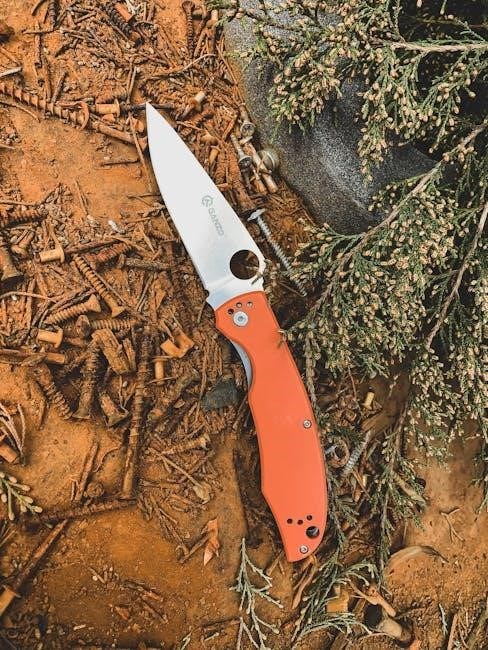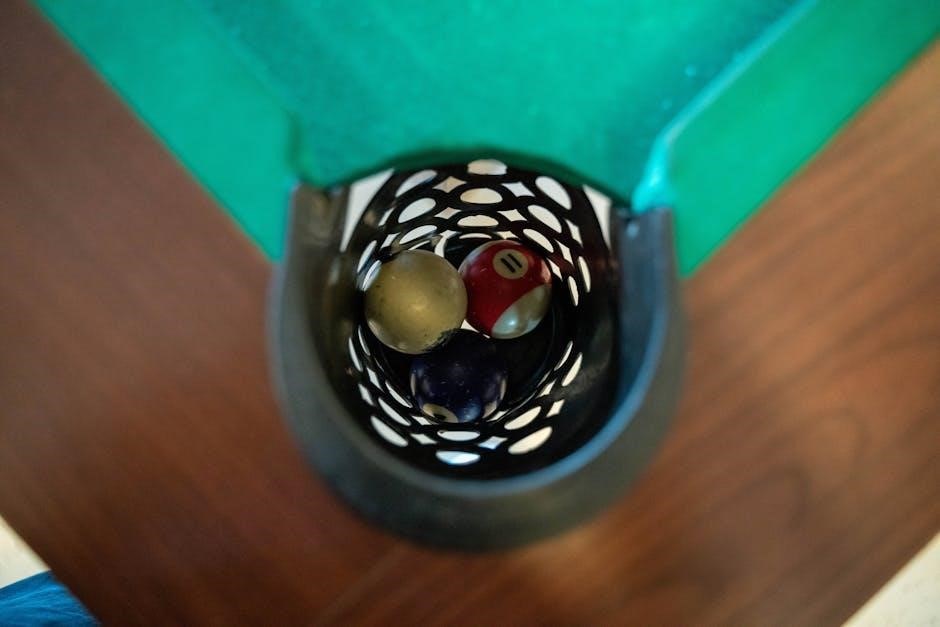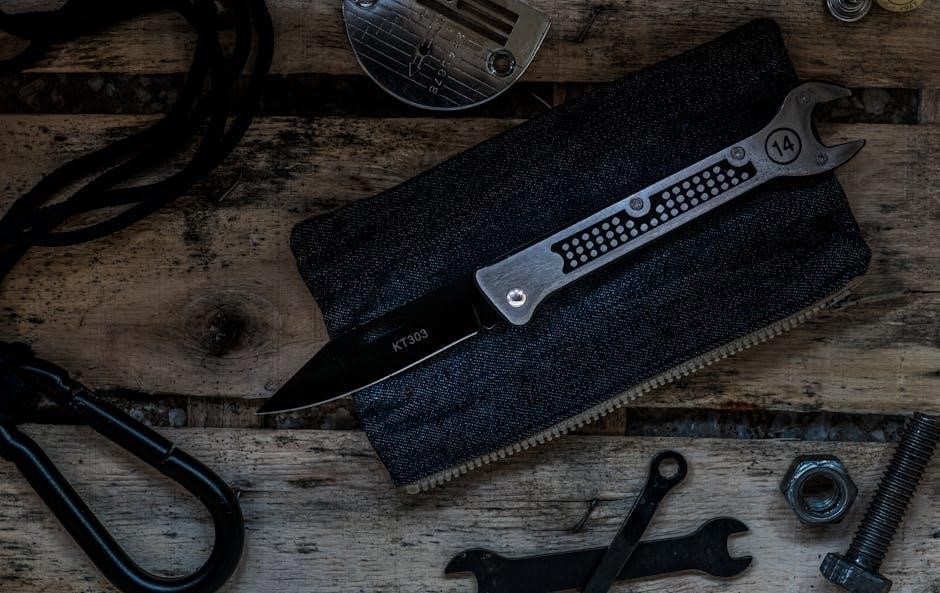Pocket hole joinery is a popular woodworking technique for creating strong, hidden joints. This guide explores the fundamentals, benefits, and best practices for using pocket hole screws effectively in various projects, ensuring durable and professional results.
1.1 Overview of Pocket Hole Joinery
Pocket hole joinery is a woodworking technique involving drilling angled holes in wood to create strong, hidden joints. A specialized jig guides the drill bit, ensuring precise placement. The screw enters the pocket hole at an angle, securing adjacent pieces. Proper hole orientation is crucial for maximum strength, with screws ideally threading into face or edge grain rather than end grain for a secure connection.
1.2 Importance of Using Pocket Hole Screws
Pocket hole screws are essential for creating durable, hidden joints in woodworking. They provide strong structural integrity by threading into the wood’s edge or face grain, avoiding weak end grain. This method ensures joints remain secure and prevents loosening over time. Using the correct screw length and type is vital, as detailed in later sections, to maximize hold and prevent material damage during assembly.

Understanding Pocket Hole Screw Components
Pocket hole screws and jigs are key components, ensuring strong joints. The screw’s coarse thread grips wood securely, while the jig guides precise drilling, preventing material splitting.
2.1 Anatomy of a Pocket Hole Screw
A pocket hole screw features a coarse, aggressive thread for strong wood grip and a sharp point for easy starting. Its unique design includes a tapered shank to reduce splitting and a countersinking head for flush seating. The screw’s self-tapping tip eliminates pre-drilling, while its deep root ensures maximum holding power in various wood densities and thicknesses, making it ideal for durable joints.
2.2 Role of the Pocket Hole Jig
The pocket hole jig is an essential tool for precision and accuracy in creating pocket holes. It guides the drill bit to ensure proper hole placement and alignment, preventing misalignment or incorrect depth. Adjustable for different material thicknesses, the jig helps maintain consistent results. Its design allows for easy spacing and positioning, making it a crucial component for achieving strong, professional-looking joints in woodworking projects.

Choosing the Right Pocket Hole Screws
Selecting the right pocket hole screws is crucial for joint strength and durability. Screw length should match material thickness to avoid over-drilling, while type ensures secure, long-lasting connections.
3.1 Determining Screw Length Based on Material Thickness
Material thickness dictates screw length to ensure proper hold without over-drilling. Thinner materials require shorter screws, while thicker materials need longer ones for stability. A general rule is to use screws that penetrate at least 1-1.5 inches into the adjacent material. Adjusting the stop collar on the drill bit helps achieve consistent depth. Proper screw length is critical for joint strength and durability, preventing screws from protruding or causing damage. Always test screw length on scrap wood to confirm fit and avoid errors.
3.2 Selecting the Correct Screw Type for Your Project
The screw type depends on the project’s demands. Coarse-thread screws are ideal for softwoods, while fine-thread screws suit hardwoods. Weather-resistant screws are best for outdoor projects, and specialty screws, like those with square drives, offer added torque. Always match the screw’s shank and tip to the material and joint type for optimal performance and durability. Correct selection ensures strong, long-lasting connections. Testing on scrap wood helps confirm compatibility and avoids costly mistakes.
Drilling Pocket Holes
Drilling pocket holes requires precise setup, using a stepped drill bit and stop collar to ensure consistent depth. Proper hole orientation is critical for joint strength and durability.
4.1 Setting the Correct Drill Bit Depth
Setting the correct drill bit depth is crucial for pocket hole joinery. Use a stepped drill bit with a stop collar to control depth, ensuring the screw doesn’t protrude. For materials of varying thickness, adjust the collar to leave a 1/8-inch gap at the hole’s bottom. This prevents over-drilling and maintains joint integrity, ensuring screws hold firmly without splitting the wood.
4.2 Ensuring Proper Hole Orientation for Maximum Strength
Proper hole orientation is essential for maximizing joint strength. Drill pocket holes so screws thread into the face or edge grain, avoiding end grain, which reduces stability. Ensure the screw tip points toward the thickest part of the material to prevent loosening over time. Align the jig correctly and use a depth stop to maintain consistent angles, enhancing the joint’s durability and ensuring a secure connection.

Using a Pocket Hole Jig
A pocket hole jig guides the drill bit for precise hole placement. Adjust the jig to fit material thickness, ensuring accurate alignment and consistent results every time.
5.1 Adjusting the Jig for Different Material Thicknesses
Adjusting the pocket hole jig for various material thicknesses ensures proper hole alignment. The jig typically features adjustable stops or collars that can be set based on the thickness of the wood. For thinner materials, like 1/2 inch, the jig is set closer to the edge, while thicker materials, up to 1 1/2 inches, require the jig to be positioned further back. This customization guarantees that the drill bit enters the wood at the correct angle, preventing errors and ensuring strong joints. Proper adjustment is crucial for maintaining consistency and avoiding misaligned screws, which can weaken the joint. Always refer to the jig’s instructions for specific adjustment guidelines, as different models may vary slightly in their mechanisms. By taking the time to accurately set the jig, you can achieve professional-grade results in your woodworking projects, ensuring durability and precision.
5.2 Tips for Accurate Hole Placement
Accurate hole placement is critical for strong joints. Always clamp the workpiece firmly to prevent movement during drilling. Use the jig’s built-in guides to maintain consistent spacing and alignment. Mark the desired hole locations beforehand to avoid mistakes. For precise results, ensure the drill bit is perpendicular to the material. Testing on scrap wood first can help confirm proper settings and technique, ensuring your final project meets professional standards.

Best Practices for Pocket Hole Joinery
Ensure screws enter face or edge grain for maximum strength. Avoid end grain to prevent loose joints. Always test settings on scrap wood before final assembly.
6.1 Avoiding End Grain for Screw Placement
Drilling pocket holes in end grain reduces joint strength, as screws may loosen over time. Always position screws to enter face or edge grain for better stability and durability.
6.2 Using Scrap Wood for Testing
Testing on scrap wood ensures accurate pocket hole placement and screw fitment without damaging your project. This step helps verify drill bit depth and jig alignment, preventing costly mistakes during assembly.

Common Mistakes to Avoid
Common errors include using incorrect screw lengths, misaligning the drill guide, and ignoring material grain direction. These mistakes can lead to loose joints or weakened structures.
7.1 Incorrect Screw Length and Material Thickness
Using screws that are too short or too long can compromise joint strength. Screws that are too short may not hold securely, while overly long screws can protrude, damaging the workpiece. Always match screw length to material thickness for optimal results, ensuring proper engagement without over-penetration. This prevents loose joints and enhances durability in pocket hole joinery applications.
7.2 Improper Drill Guide Alignment
Improper alignment of the drill guide can lead to angled or misaligned pocket holes, weakening the joint. Always ensure the jig is clamped securely and aligned with the material’s edge. Using a high-quality jig and maintaining steady hands helps prevent this issue. Misaligned holes can cause screws to enter at unwanted angles, reducing joint strength and durability. Proper alignment is crucial for achieving strong, professional results in pocket hole joinery.
- Use a high-quality pocket hole jig for consistent results.
- Clamp the material firmly before drilling.
- Double-check alignment with the material’s edge.

Troubleshooting Pocket Hole Issues
Troubleshooting pocket hole issues involves identifying common problems like loose joints or misaligned screws. Ensuring proper clamping, alignment, and material preparation can resolve most issues effectively. Always test settings on scrap wood first to avoid costly mistakes and ensure precise results in your woodworking projects.
- Check drill bit alignment and depth settings.
- Verify material thickness matches screw length;
- Use scrap wood for testing drill guide accuracy.
8.1 Fixing Loose Joints
Loose joints can occur due to incorrect screw length, misaligned drill guides, or insufficient clamping. To fix this, ensure screws match material thickness and test settings on scrap wood first. Proper clamping during assembly is crucial to prevent movement. If joints remain loose, consider using wood glue for added strength or adjusting the drill guide for better alignment. Always double-check screw placement before driving them in.
- Verify screw length matches material thickness.
- Ensure proper clamping during assembly.
- Test drill guide accuracy on scrap wood.
8.2 Addressing Misaligned Screws
Misaligned screws can weaken joints and require immediate attention. Ensure the drill guide is properly aligned with the material’s edge or face grain. If screws are crooked, check the jig’s positioning and adjust for accurate placement. Testing on scrap wood first can help prevent such issues. Always verify that the screw will enter the board at the correct angle to avoid misalignment and ensure maximum strength in the joint.
- Check drill guide alignment before drilling.
- Test screw placement on scrap wood.
- Ensure screws target face or edge grain.
Mastery of pocket hole joinery requires practice and attention to detail. Always use proper techniques, tools, and materials to ensure strong, durable joints. Refer to this guide for future projects and explore advanced methods to enhance your woodworking skills.
9.1 Summary of Key Takeaways
Pocket hole joinery is a versatile and efficient method for creating strong, hidden joints in woodworking. Proper techniques, such as accurate hole placement and correct screw selection, are essential for durability. Always use a jig for consistency and test settings on scrap wood. Avoid end grain and ensure screws engage face or edge grain for maximum strength. Follow best practices to achieve professional-quality results in your projects.
9.2 Advanced Techniques for Mastering Pocket Hole Joinery
Mastering pocket hole joinery involves refining techniques for precise alignment and optimal strength. Optimize drill depth based on material thickness to prevent over-drilling. Ensure hole orientation aligns with the project’s load-bearing requirements. Experiment with adjustable jigs for varying material sizes and angles. For complex projects, use advanced alignment methods to maintain joint integrity. Practice on scrap wood to refine your skills and achieve flawless results consistently.